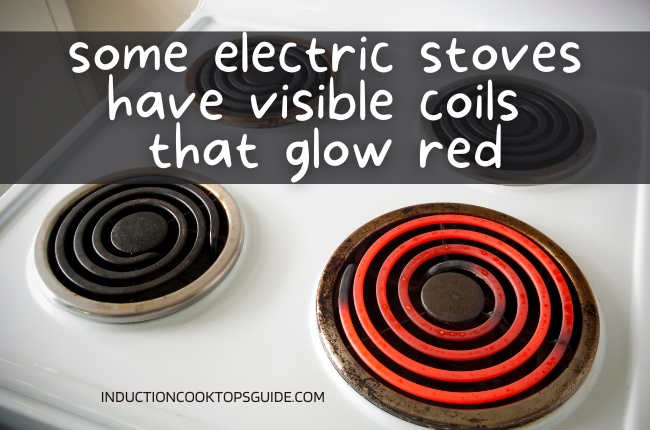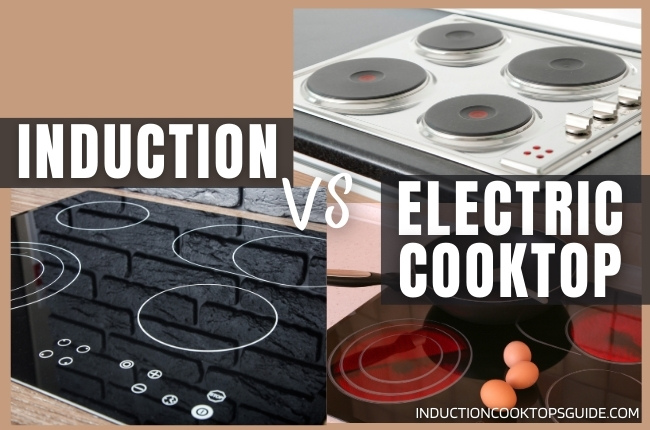Kitchen stoves are one of the common appliances that received a tremendous glow-up (that means “improvement” in Gen Z vocabulary) in recent years, thanks to technology.
We are so used to seeing gas burners with bulky and heavy metal spare parts that we are simply confused when we see posh cooktops made from glass and ceramic.
Can a cooktop really “cook” without fire? If yes, how does it work?
This article will serve as an introduction to the new breed of kitchen stoves: induction and electric cooktops.
How to tell the difference between induction and electric cooktops
So, how do we tell these cooktops apart from each other?
In appearance, the latest induction and electric cooktops models have very similar features that are almost indistinguishable.
But, if you know what features to look out for, then you will be able to tell which is an induction cooktop and which is electric.
Let’s talk about the features that appear on both cooktops on certain models and the features that are exclusive to either one regardless of the model.
Cooktops, in general, are conveniently placed on a hole in the kitchen countertop that is specifically measured for them. As a result, the cooktop and the kitchen countertop are at the same level. There are no uneven bumps in the countertop, giving the countertop an overall seamless feel.
If you want to improve the aesthetics of your kitchen, you might want to consider this installment feature exclusive to cooktops.
The most obvious difference between an induction cooktop and an electric cooktop would be the visible metal coils of electric cooktops.
Older models of electric cooktops have visible metal coils or metal plates on their exterior. These coils act as the stove’s main heat provider and glow red when heated.

Induction cooktops also have coils, but they are usually hidden under a smooth glass surface. Unlike the metal coils of electric cooktops, the copper coils of induction cooktops do not glow when heated.
However, some electric cooktops also have hidden coils underneath a glass surface. In this case, you will only know that it is an electric cooktop if the coils beneath the glass glow when hot.
Aside from the coils, another thing that you can look out for is the knobs.
If you cannot see the coils of the cooktop but you see regular, round knobs similar to gas stovetops, it is probably an electric cooktop.
Induction cooktops rarely have knobs. Instead, they have soft buttons that control not only heat settings but also the timer and safety settings, among other advanced features.
But, since immediate improvements are possible with technology, the latest models of electric cooktops have copied the soft button feature of induction cooktops as well. Now, this is where they are almost indistinguishable at first glance.
Imagine, both have smooth glass surfaces and invisible coils. Both have soft buttons instead of knobs. Both have light-colored circles drawn on their surface that serve as a cookware alignment guide.
How can we visually tell them apart? At this point, it is almost impossible unless you heat them both up, and whichever glows red is the electric one.
If their physical features are so similar, you would not need to worry about which one would better fit the aesthetic of your kitchen. Aside from appearance, these two cooktops also differ in their function.
Technically speaking, electric and induction cooktops are “electric” since they both depend on electricity. What separates them from each other is that they transfer heat differently.
Electric cooktops, on one hand, have electric coils which heat up because of electricity. Now, when these coils heat up, the heat gets transferred to the cookware’s surface via conduction, which, in turn, heats whatever is inside the cookware.
Induction cooktops, on the other hand, heat up electromagnetically. An electromagnet becomes magnetic and heats up when it is filled with high voltages of electric current.
When this happens, the heated electromagnet transfers heat to the nearest magnetic object that can induct its heat.
This is why induction cooktops require cookware made from cast iron or stainless steel. Otherwise, electromagnetic induction will not work. We will talk about this in detail later.
In sum, electric cooktops heat the cooktop’s surface, then the cookware, then the food. Meanwhile, induction cooktops skip the non-magnetic surface and instead directly heat up the magnetic cookware via electromagnetic induction.
Now that we know how induction and electric cooktops differ in performance and appearance, let us consider other factors.
To help you know which one to get, considering things like efficiency and power consumption could help you make better decisions. Which cooktop offers the better benefits?
Induction vs. Electric Cooktop Pros and Cons
Let us begin with naming the pros and cons of each cooktop while comparing them with each other at the same time.
Induction Cooktop Pros
1. Faster cooking times.
Induction cooktops can boil a small pot of water in as fast as 2 minutes. This is faster than any other cooktop or electric kettle. How is this possible?
Electric cooktops transfer heat via conduction. This means that a heated surface has to touch another surface to transfer heat. In electric cooktops, the coils heat up first, then the surface of the cooktop next, then the cookware, then the food inside the cookware.
Meanwhile, induction cooktops transfer heat via electromagnetic conduction. The heated copper coils create a magnetic field and directly heat up the nearest magnetic object. Thus, induction cooktops skip heating the glass-ceramic surface resulting in a much faster heat transfer.
2. Precise temperature control.
You can easily control the temperature setting exactly how you want it. Also, the temperature settings change in real-time.
Electric cooktops do not offer this luxury as it takes some time for the electric coils to heat up and then cool down or vice versa.
3. Safe.
Unlike gas stoves and electric cooktops, induction cooktops do not give off heat in the air. It is less likely to cause a fire since it cannot heat non-magnetic objects like clothes or potholders.
4. No residual heat.
As mentioned earlier, temperature changes in real-time with induction cooktops. So, if you turn it off, the temperature will drop automatically.
Also, no residual heat means that no heat “escapes” the process of induction. This leaves you with a much cooler kitchen compared to when you use electric or gas cooktops.
Induction Cooktop Cons
1. More expensive.
Although the prices have gone lower in recent years, induction cooktops are still generally more expensive than its electric or gas counterparts.
2. Requires special cookware.
Induction will not work on glass and Teflon pans.
If you want to shift to an induction cooktop, you might need to completely revamp your cookware collection. Replace all non-magnetic stuff with cast iron, stainless steel, or anything that attracts a magnet.
You also need flat-bottomed pots to ensure quick and even heat distribution. More than that, your pans need to be at least 8 centimeters in diameter. Any size lower than that will not activate the induction cooktop’s magnetic field.
3. Steep learning curve.
When working with an induction cooktop, you have to use suitable pans. If the pan is too small, or if you place the pan a little farther from the center, the heating element may not be activated.
And if you move your pan around while cooking, the heat may shut off without warning. You really need to get the hang of induction cooktops before you appreciate the benefits it offers.
Electric Cooktop Pros
1. Affordable.
Electric cooktops are still generally cheaper than induction, even if they are similar in build and design.
2. Easy to use.
Unlike induction cooktops, electric cooktops are much more intuitive to control. It doesn’t need special pans. It doesn’t require a particular position for the pans to heat up.
The electric cooktop can get the job done as long as the pans touch the heating surface.
3. Residual heat can also be an advantage.
You can use the residual heat to keep your pots warm, especially when you do not have to serve the food right away.
As for the residual heat’s impact on the overall kitchen temperature, you can avoid it by having adequate ventilation.
Electric Cooktop Cons
1. Poor temperature control.
As mentioned earlier, the coils of electric cooktops are very slow to change in temperature. If you lower the temperature on the knobs, the cooktop surface will take a while before reaching your desired temperature.
2. Tough clean-up if food burns on its surface.
If you are the type of cook who cannot avoid spills every now and then, cleaning up an electric cooktop might be a hassle for you.
This disadvantage does not exist on induction cooktops because their surfaces do not heat up. In fact, you can actually clean them while you are cooking.
3. Uneven distribution of heat.
Sometimes, the electric coils can become faulty, which results in uneven cooking.
Induction vs. electric efficiency
Aside from the benefits and drawbacks mentioned above, we also need to weigh the energy efficiency of the cooktops.
Studies show that electric cooktops have 70% energy efficiency, meaning that 70% of the electricity they consume is used for cooking food. The other 30% goes somewhere else.
Meanwhile, induction cooktops have 90% energy efficiency. With this, we can conclude that induction cooktops are more energy efficient than electric cooktops.
If you are a gas stove user, I would like to help you put the information above into perspective: gas stoves are only 40% energy efficient.
Imagine how much energy you will save if you shift to either electric or induction cooktops.
Induction cooktop vs. electric power consumption
From the previous section, we have already established that induction cooktops are the most energy-efficient cooktops when compared to gas stoves and electric cooktops.
So, does that energy efficiency translate to electric power consumption?
Since electricity is bought in kilowatts per hour (kWh), let us try to measure how much time it would take for an induction cooker to consume one kWh.
Research shows that most induction cookers consume 1,400 watts per hour. To convert this into kWh, simply multiply the electric consumption in watts times the number of hours the equipment functioned. Then, divide it by 1000.
In our case, 1,400 watts times 1 hour divided by 1,000 is 1.4. So, that is 1.4 kWh. Your induction cooker consumes 1.4 kilowatts of electricity per hour.
To know how much you’ll pay for it, multiply the kWh that we just computed by the cost of one kWh (according to your electricity provider).
In the US, the average cost of electricity is around 12 US centavos per kWh. If we apply this to our case, 1.4 kWh times 12 centavos/kWh is 16.8 centavos. This means that an average US citizen pays 16.8 US centavos for every hour their induction cooker operates.
Isn’t that a steal? Although induction cookers are expensive when first bought, they are undeniably energy- and cost-efficient in the long run.
To better understand just how efficient an induction cooker is, let us compare it to its gas and electric counterparts.
A medium-sized gas burner consumes 2 637 watts per hour of use. That is around 2.6 kWh–31.2 US centavos when paid for by an average US citizen.
An electric cooktop uses 0.32 kWh to boil 2 liters of water, while an induction cooktop consumes 0.225 kWh to do the exact same thing.
In the long run, induction cooktops consume a significantly lesser amount of electricity.
It’s still up to you!
Despite all the information posted above, you should still choose which cooktop better suits your lifestyle, preferences, and priorities.
If you value energy consumption and are willing to buy new cookware, induction cooktops are the most compatible choice.
But if you value familiarity and do not mind spending a few more cents for every kWh consumed, it is best to stick with an electric cooktop.

Leave a Reply